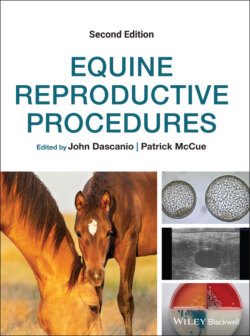Читать книгу Equine Reproductive Procedures - Группа авторов - Страница 17
Оглавление6 Removal of a Persistent Hymen
John J. Dascanio
School of Veterinary Medicine, Texas Tech University, USA
Introduction
The hymen may be a complete or partial tissue wall separating the vagina and vestibule. The hymen is usually ruptured at breeding or disrupted manually during artificial insemination. Once the hymen is opened, the remaining tissue is referred to as the vestibulo‐vaginal fold. The purpose of the vestibulo‐vaginal fold is to act as a one‐way valve, helping to prevent air and contaminants from entering the vagina.
Occasionally, the hymen is very thick and accumulates a significant amount of secretions behind it. These secretions may be vaginal or uterine in origin. Typically, the secretions have a white liquid to mucoid consistency.
If the hymen does not rupture with digital pressure, a surgical procedure may be needed to open the thickened membrane. Care should be taken to ensure that there is a complete reproductive tract on the vaginal side of the hymen, as segmental aplasia of the reproductive tract could be present with thickened hymenal tissue. Transrectal ultrasound may be used to visualize accumulated fluid within the vagina/cervix/uterus to confirm the presence of the reproductive tract. Conversely, a small hole may be created in the hymen and an endoscope used to explore the tissue in front of the hymen to confirm that the vagina and cervix are present before expanding the incision in the hymen.
Equipment and Supplies
Tail wrap, tail rope, non‐irritant soap, roll cotton, stainless steel bucket, disposable liner for bucket, paper towels, surgery gloves, basic surgical pack, sedation, local anesthetic, needles and syringes.
Technique
Remove feces from the rectum.
Place a tail wrap and a tail rope.
Clean and dry the perineum (see Chapter 3).
For a thin membrane hymen, a finger or blunt‐tipped instrument such as the end of closed Metzenbaum scissors may be used to exert pressure on the central aspect of the hymen to disrupt it. The hand should be able to extend beyond the hymen to ensure that the hymen is opened adequately for breeding.
For a thick membrane hymen, using Addison tissue forceps or towel forceps, grasp the hymen near its center and pull outward to evert it through the vulvar opening (Figure 6.1).Figure 6.1 A thick hymen grasped with sponge forceps. A small hole was created with a scalpel blade and a creamy white discharge can be seen exiting the incision.
If the mare resents manipulation of the hymen, a local anesthetic may be infiltrated into the surrounding tissue or an epidural may be performed.
For a thick hymen, a 1 cm hole is carefully created near the center of the hymen using a scapel or scissors.
Any discharge from the cut hole should be noted at this time. Typically a white liquid will discharge, which is an accumulation of uterine/vaginal secretions.
Using a finger, small speculum, or endoscope, examine the area just cranial to the hole in the hymen to confirm the presence of a normal reproductive tract. In some cases, agenesis of the reproductive tract may be present, and further surgical intervention should be discontinued. Confirmation of an intact reproductive tract may also be done with palpation and ultrasound examination per rectum.
Once a normal reproductive tract is confirmed, the hole may be enlarged with Metzenbaum scissors so that a circular area of hymen is removed.
Care should be taken to leave a rim of tissue around the hymen so as to not compromise the wall of the vestibule or vagina (Figure 6.2).
Occasionally, it may be necessary to dilate the remaining tissue with the balloon from a Foley catheter to enlarge the vestibulo‐vaginal area.
Interpretation
A creamy white discharge with some hemorrhage may be present for a few days post‐surgery.Figure 6.2 The incision is enlarged with Metzenbaum scissors and a circular piece of tissue removed from the central aspect of the hymen.
The mare should not be bred immediately after surgery, but may be bred at the next estrus, to make sure that any pathology from the pressure from retained vaginal/uterine secretions can resolve first.
Occasionally a stricture may form after removal of a significant hymen, which may require future dilation or possibly laser surgical removal.
Generally, no aftercare is required.
